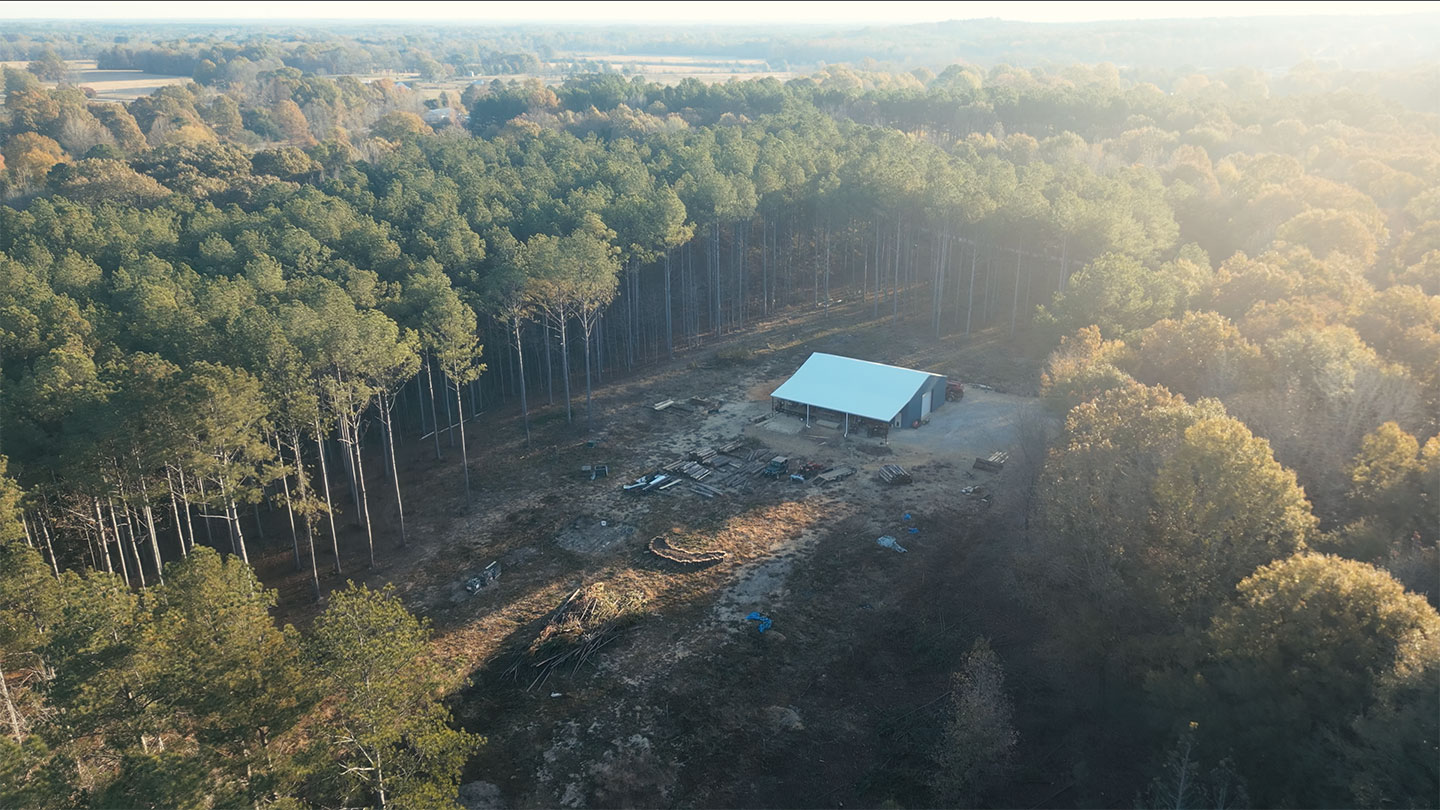Your cart is currently empty!
Another beautiful day in the woods. Our own slice of paradise is taking shape each day.

Today I have to take down a large loblolly pine. This tree was 24″ at the base and about 130′ tall. My four wheeler has turned into my mobile logging and tree felling headquarters. Having everything I need strapped to transporation is something I can’t live without now.

The tall beauty in the center is the tree that I need. These trees are commercially planted loblolly pines. According to the Mississippi Forestry Commission, these pines typically have an average lifespan of 40 years. In the world of trees, that lifespan strikes me as pretty short. I don’t know if that’s specific to the species in general or due to the way they are planted. Regardless, their current age and the fact that we have beetles killing some of them is encouraging us to take them all down as needed. Today, I need this one.

Prior to this property, I had never cut a tree down. I’ve cut a decent amount of firewood, but it was always from trees or logs already on the ground. I’ve learned everything I know about felling trees from watching Buckin’ Billy Ray Smith on YouTube. The guy is a wealth of knowledge and positivity. While I’ve never kept up with the number of trees I’ve taken down, I probably have around 100 of these mature pines under my belt, and exponentially more grapefruit-sized trees. Every tree is another day at tree-felling school. We’re all constantly learning until we quit breathing.




I like to analyze the results after each of these mature trees comes down. Figuring out exactly what happened, good and bad, is the first step in thinking about improvement. In this case, the 24″ bar on my saw wasn’t quilte long enough to make the entire cut in one pass, so a small chunk ripped out of the stump on the way down. No damage to the logs and the tree came down safely. But it’s good to understand why little stuff like this happens.

Now to establish logs. There was a bend around 18′ away from the felling cut, which was a perfect starting point. Cutting here first eliminates the bend being in any of the logs and it allowed two 8’+ logs to be cut from the lower part of the tree. While the tree did have a decent bend in it, I was able to get six nearly perfectly straight 8’+ logs. Perfect!


The MVP of our property continues to be this tractor. It’s a Bad Boy 4035H, and I picked it due to the loader lift capacity. This loader is rated to lift 2,200lbs. Twice as much as the Kubota equivalent. According to an online calculator, this log is around 1350lbs and the tractor lifted and curled it with ease.

With our sawmill in full swing, we have a routine biochar process going. Well, we burn what doesn’t sell and is too difficult to chip and pull the ash and half burnt chunks for our compost from time to time.

The log commute to and from work..





Pine is notoriously sappy. You can literally see the log draining while on the sawmill.


Lumber is much neater when stacked if you take the time to square up the ends of the logs before cutting into lumber.

A couple of beauty shots of the log on the mill. What a beauty indeed!



The first few cuts give a glimpse into the inside. This is hands down the best quality log of any species I’ve milled.

It’s also pretty darn heavy. Skip the gym membership and get a sawmill! This log changed the way I turn big logs into a square cant. With smaller logs, it’s relatively easy to rotate the log 90 degrees and align the first face cut against the log stops to cut the first 90 degree corner. With a log this large and heavy, I struggled to get the first face cut aligned properly. I got it, but it was tough.
In the present time, I’ve cut all four of the large logs needed for this job. I’ve learned that it is much easier with big logs to work on the two opposite sides first, so no heavy balancing is required. Just flip the log over and get the log down to the 10″ thickness for one dimension of the required cant. At that point, not only is a decent amount of the weight removed, making it easier to manipulate, you also have a much larger face cut to reference off of the logs stops to dial in the first 90 degree cut.

My mill is a fully manual Timber King 1220CRZ. No hydraulics and no built-in toe board. I have a spare camper stabilizer jack clamped to two of the frame beams and use it to elevate the smaller diameter of the log as needed,

Once the cant is formed, I put the boards that are in need of edging against the cant and work my way through the rest of the cuts. This allows me to square the edges of the boards removed before the cant is formed. Sometimes I find this process easier to do when the cant is still oversized. Most of the time, it makes sense to wait until the cant is down to its final size, use it essentially as a clamping block to hold the boards upright, and then focus on edging the boards.


As winter approaches, daytime sunlight decreases, and we are starting to work under the lights. Jamie has been a tremendous help when running large jobs on the sawmill. She takes the time to brush the sawdust off the boards and sticker stack them on the pallets. She’s a trooper!

Beautiful pine! Just beautiful.

And the 10×10 porch post is a beauty as well. One down, three to go.



Leave a Reply